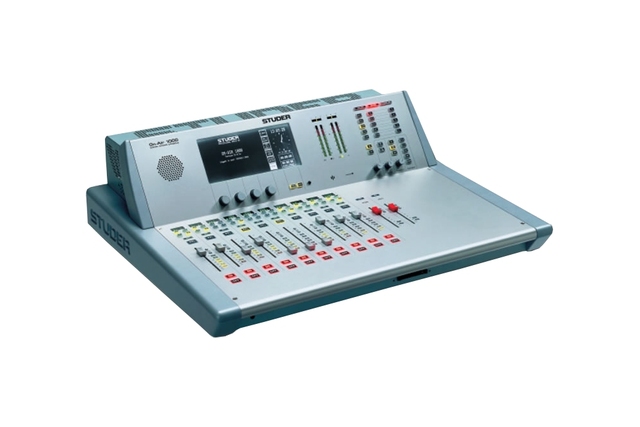
The Studer OnAir 1000 brings reliable digital technology and the proven Touch-n-Action operating concept of the Studer OnAir 2000 to a lower-priced segment of the market.
Studer’s patented Touch-n-Action graphical user interface makes the Studer OnAir 1000 unique in its class. Mixer settings can be personalized and stored for each operator. Management of user access rights reduces the risk of human error during production and live transmission. The Studer OnAir 1000 is available in two different versions, one for predominantly analog environments, the other for predominantly digital environments. The mixer is equipped with 10 channel faders and 2 master faders which retain the most important operating elements and adjacent readouts.
The mixer’s standard features are impressive and include a comprehensive monitoring section, 2 analog inserts, a serial interface, GPIO, and more. Professional integration into a radio automation system therefore is an easy task. In addition to a mains input, the console is fitted with a separate socket for 24 V DC, which can be used together with the mains.
The attractively designed Studer OnAir 1000 was developed for production and live broadcasting in both network and local radio stations.
Studer’s patented Touch-n-Action graphical user interface makes the Studer OnAir 1000 unique in its class. Mixer settings can be personalized and stored for each operator. Management of user access rights reduces the risk of human error during production and live transmission. The Studer OnAir 1000 is available in two different versions, one for predominantly analog environments, the other for predominantly digital environments. The mixer is equipped with 10 channel faders and 2 master faders which retain the most important operating elements and adjacent readouts.
The mixer’s standard features are impressive and include a comprehensive monitoring section, 2 analog inserts, a serial interface, GPIO, and more. Professional integration into a radio automation system therefore is an easy task. In addition to a mains input, the console is fitted with a separate socket for 24 V DC, which can be used together with the mains.
The attractively designed Studer OnAir 1000 was developed for production and live broadcasting in both network and local radio stations.
Technical Specifications:
Level specs, digital, in dBFS: dB, referenced to full modulation (dBFS, dB Full Scale)
Level specs, analog, in dBu: 0 dBu 0.775 Vrms
Level specs, analog, in dBuFS: Level in dBu for full modulation ( 0 dBFS)
Sampling rate: 48 kHz ±100 ppm (internally synchronized)
Headroom adjustable: 9 to 19 dB
Default setting: 9 dB
Output level: 15 dBu @ 0 dBFS
All input faders set to their 0 dB position. External analog sources: Source impedance
< 200 W. Frequency range: 20 Hz to 20 kHz, if not stated otherwise.
Microphone Input Units Microphone input units have A/B-switchover and are equipped with a balancing
transformer and XLR connectors. The signal is routed to an electronically balanced,
analog insert point before the A/D-converter.
Input sensitivity –60 to +20 dBuFS (with 9 dB headroom: –69 to +11 dBu)
Gain setting in steps of 1 dB
Phantom power, switchable 48 V
Frequency response ±0.5 dB
High-pass filter (12 dB/Octave) –3 dB @ 75 Hz ±5 Hz, switchable
Input impedance > 1 kW
Insert level +15 dBuFS (with 9 dB headroom: +6 dBu)
A/D converter 24 bit (Delta-Sigma, 64 × oversampling)
Dynamics typ. 102 dB (unweighted)
THD+N < –85 dBFS, 20 Hz to 20 kHz, @ –1 dBFS
THD+N < –100 dBFS, 20 Hz to 20 kHz, @ –30 dBFS
Noise figure typ. < 4 dB @ max. gain, bandwidth 20 kHz, Rs = 200 W
Common mode rejection > 50 dB @ 15 kHz, > 75 dB @ 50 Hz
Line Level Input Units Analog line level input units have A/B-switchover and are equipped with an electronically
balanced input and XLR connectors.
Input sensitivity for 0 dBFS 0 to +24 dBuFS (with 9 dB headroom: –9 to +15 dBu)
Gain setting in steps of 1 dB
Frequency response ±0.1 dB
Input impedance > 10 kW
A/D converter 24 bit (Delta-Sigma, 64 × oversampling)
Dynamics typ. 102 dB @ +15 dBuFS (unweighted)
THD+N < –94 dBFS, 20 Hz to 20 kHz @ –1 dBFS
THD+N < –100 dBFS, 20 Hz to 20 kHz @ –30 dBFS
Common mode rejection > 47 dB @ 50 Hz to 15 kHz
Digital InputUnits Digital input units have A/B-switchover. AES/EBU (AES3-1992) and S/PDIF
(IEC 958) formats are supported; XLR, Cinch/RCA, and TOSlink connectors are
available.
All digital input units are equipped with a sampling frequency converter (SFC).
SFC resolution 20 Bit
Input sampling rate 30 to 54 kHz
THD+N < –105 dBFS @ 1 kHz, 0 dBFS
Frequency response ±0.1 dB
Input impedance 110 W (XLR connectors); 75 W (Cinch/RCA connectors)
Analog Outputs Analog outputs are transformer-balanced with XLR connectors.
Output level +4 to +24 dBu @ RL = 100 kW;
+4 to +23 dBu @ RL = 300 W
D/A converter 24 bit (Delta-Sigma, 128 × oversampling)
Dynamics typ. 101 dB (unweighted)
THD+N < –90 dBFS @ 1 kHz, –1 dBFS
Frequency response ±0.2 dB
Output impedance < 40 W
Digital Outputs Digital outputs are equipped with two independent outputs according to the
AES/EBU standard (AES3-1992). On each of these outputs, the same signal is fed
to two XLR sockets with individual buffers.
Output level 2 to 5 V
Output impedance 110 W
Equalizer Treble control (High) 5 kHz/10 kHz: ±15 dB (depending on Customer Code setting; refer to 11.2.11)
Equalizer (Mid) 200 Hz to 10 kHz: ±15 dB
Bass control (Low) 200 Hz/400 Hz: ±15 dB
Crosstalk Attenuation
Between channels > 90 dB
Input fader attenuation > 100 dB
Power Supply Redundant power supply
Mains voltage 100 to 240 V, 50/60 Hz (auto-ranging)
Power consumption 130 VA typ.
DC operation 24 VDC +15/–10 %; typ. 5 A @ 24 V